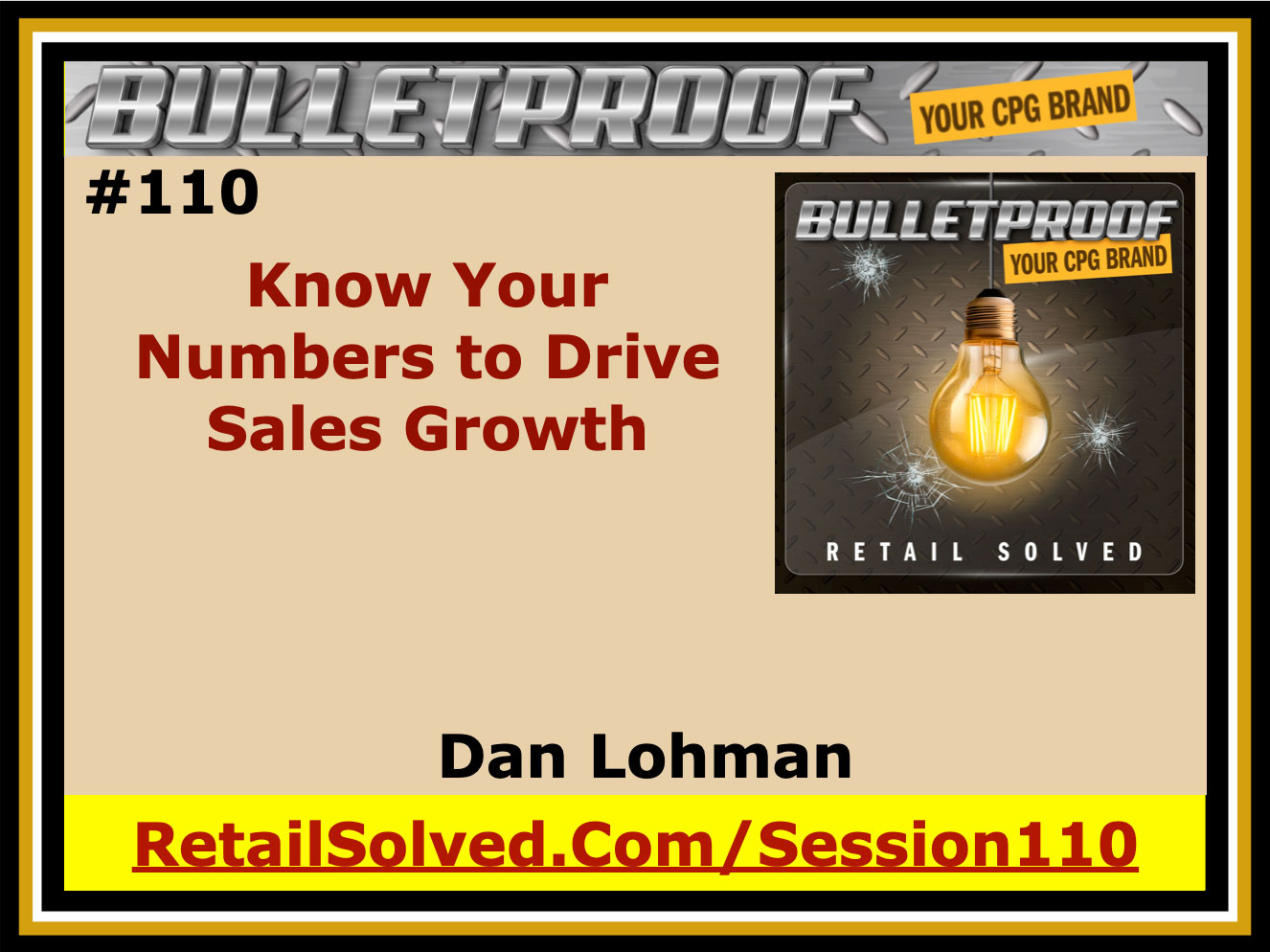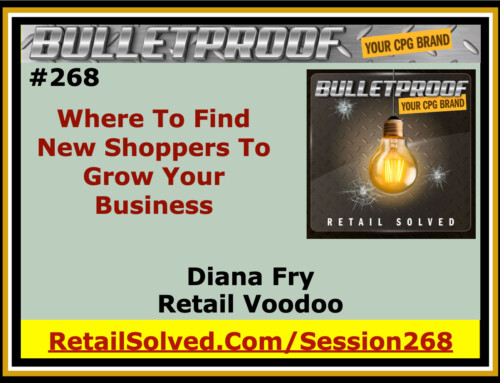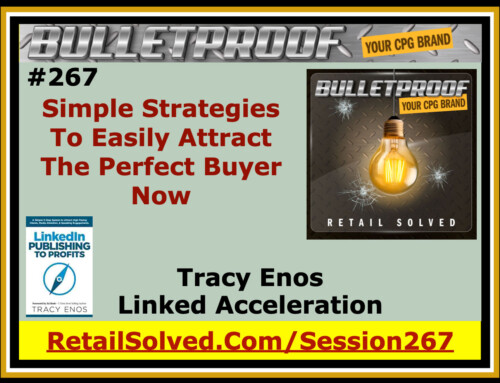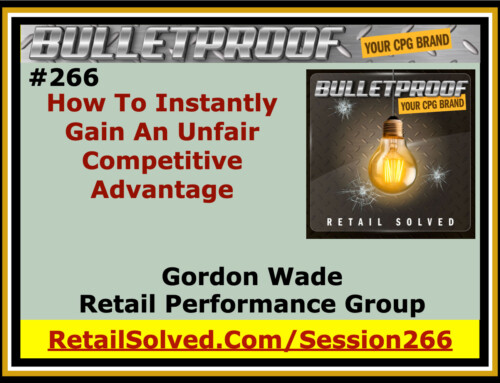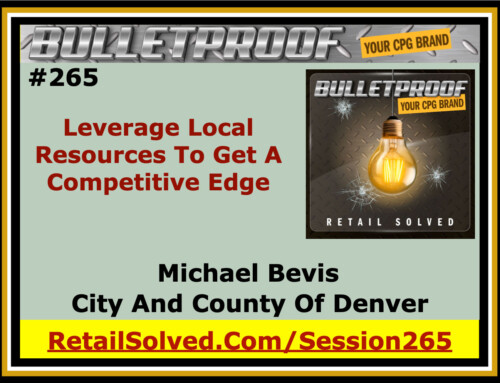Unlock future success by understanding the importance of knowing your numbers for brand growth and retail competition. The mini-course, “Mining the Data Maze,” teaches brands how to create innovative reports that provide actionable insights beyond the canned top-line reports used by others. Personalized analysis featuring your unique shoppers needs, will give you the edge you deserve.
Knowing your numbers is the key to unlocking your future success. They can determine how long your brand will be around & help you compete at the highest levels. Going beyond canned topline reports will differentiate your brand – what retailers REALLY want.
Welcome. The number-one question I get asked by brands listening to my podcast and reading my weekly newsletter is, “What are the best reports that I need to drive sales and grow my brand?”
This is also the number-one question I get asked when I mentor or work with brands. I've had the privilege of working with literally hundreds of brands in all stages of development, from pre-revenue to multi-billion-dollar companies. Sadly, most brands use reports that do not reflect how customers buy their products, even the big brands. This is an expensive and huge waste of money.
You've probably been told that bringing top-line canned reports to your retail appointments is critical to your success. The reality is that most top-line canned reports are simply a waste of ink and paper.
Sounds like a pretty harsh statement? Let me explain. Savvy retailers already know how your brand is performing on their shelves. They do not need a report confirming what they already know. They do not need a report telling them the exact same thing that every other brand is telling them, only with your unique spin. What they really need are actionable insights that they do not have access to on their own. They need actionable insights that your competitors are not providing them. Retailers also need you to help them compete more effectively in their markets.
Every retailer needs to know that if they put your product on their shelves that it will grow category sales and increase shopper traffic in their stores. Once that happens, you then need to validate and reinforce that your brand deserves to remain on their shelves because it continues to achieve those results.
Before I go any further, I want to remind you that there's a free downloadable guide for you at the end of most every podcast episode. I always try to include one easy to download, quick to digest strategy that you can instantly adopt and make your own, one that you can use to grow sustainable sales and compete more effectively. Remember, the goal here is to get your product onto more retailer's shelves and into the hands of more shoppers.
If you like the podcast, please subscribe, share with a friend and leave a review.
Retailers want insights, actionable insights. The most effective way to do that is with sales data, fact-based selling. Most selling is what I would call relationship selling, using what I would call the push method. This is the strategy that most every brand adopts because they simply don't know any better. With the push method, your checkbook is the most important tool in your arsenal. With this strategy, you're more likely to get onto a retailer's shelf if they have a relationship with you and if your pockets are deep enough.
Download the show notes below
Listen where you get your podcast
Important: Brand Secrets and Strategies has been rebranded to Retail Solved. Please swap all BrandSecretsandStrategies.com URL’s with RetailSolved.com. This is now the Bulletproof Your Brand podcast. Thank you for listening! BRAND SECRETS AND STRATEGIES PODCAST #110 Hello and thank you for joining us today. This is the Brand Secrets and Strategies Podcast #110 Welcome to the Brand Secrets and Strategies podcast where the focus is on empowering brands and raising the bar. I’m your host Dan Lohman. This weekly show is dedicated to getting your brand on the shelf and keeping it there. Get ready to learn actionable insights and strategic solutions to grow your brand and save you valuable time and money. LETS ROLL UP OUR SLEEVES AND GET STARTED! Welcome. The number-one question I get asked by brands listening to my podcast and reading my weekly newsletter is, "What are the best reports that I need to drive sales and grow my brand?" This is also the number-one question I get asked when I mentor or work with brands. I've had the privilege of working with literally hundreds of brands in all stages of development, from pre revenue to multi-billion-dollar companies. Sadly, most brands use reports that do not reflect how customers buy their products, even the big brands. This is an expensive and huge waste of money. You've probably been told that bringing top-line canned reports to your retail appointments is critical to your success. The reality is that most top-line canned reports are simply a waste of ink and paper. Sounds like a pretty harsh statement? Let me explain. Savvy retailers already know how your brand is performing on their shelves. They do not need a report confirming what they already know. They do not need a report telling them the exact same thing that every other brand is telling them, only with your unique spin. What they really need are actionable insights that they do not have access to on their own. They need actionable insights that your competitors are not providing them. Retailers also need you to help them compete more effectively in their markets. Every retailer needs to know that if they put your product on their shelves that it will grow category sales and increase shopper traffic in their stores. Once that happens, you then need to validate and reinforce that your brand deserves to remain on their shelves because it continues to achieve those results. Before I go any further, I want to remind you that there's a free downloadable guide for you at the end of most every podcast episode. I always try to include one easy to download, quick to digest strategy that you can instantly adopt and make your own, one that you can use to grow sustainable sales and compete more effectively. Remember, the goal here is to get your product onto more retailer's shelves and into the hands of more shoppers. If you like the podcast, please subscribe, share with a friend and leave review. Retailers want insights, actionable insights. The most effective way to do that is with sales data, fact-based selling. Most selling is what I would call relationship selling, using what I would call the push method. This is the strategy that most every brand adopts because they simply don't know any better. With the push method, your checkbook is the most important tool in your arsenal. With this strategy, you're more likely to get onto a retailer's shelf if they have a relationship with you and if your pockets are deep enough. Fact-based selling, in this situation, is where you take a top-line canned report and lay it on the retailer's desk and hope that they're impressed. What I recommend instead is the pull strategy. The pull strategy is where you develop a relationship with the retailer where you are now a trusted and respected partner. In this role, you actually become an advisor for the retailer and your advice, your insights about the category and the shopper who buys the products in the category, are far more important to the retailer than your checkbook. Fact-based selling, in this situation, is where you dig deep into the category and help the retailer understand why consumers shop the category, why they choose one product over another, why they choose one retailer over nothing, and what's in the shopper's market basket when they check out. Savvy retailers know and understand that your ability to help them grow sustainable sales in their category, is far more impactful and far more rewarding to them and to their bottom line, than simply collecting a check for you every time you have a promotion or introduce a new item. This is how you become a category leader. A category leader is any brand willing and able to step up and help the retailer, to help guide them to drive sustainable sales in the category. With this in mind, it's critical that you use the right kind of data to tell your selling story, and differentiate your brand from your competitors. You've been told to focus on how your brand ranks in the category against other brands. Natural brands do not have the velocity to rank high in mainstream stores. The issued reports actually paint your brand in a dim light. Traditional methodologies focus exclusively on metrics that overlook the contribution natural brands provide. I have a much better solution that has a long, successful track record. This is the strategy that I use with my clients. Brands need to go beyond the top-line canned reports. Brands need to learn how to mine the data maze. They need to include actionable insights that tell a compelling story, what retailers really want. Before we go any further, let me help frame this topic. When I say that I'm an expert in category management, what I'm saying is that that's just not a title. I am literally the first person certified at the highest level category management proficiency, a certified professional strategic advisor, CPSA. You typically see people with that skillset, with that designated, as the vice president of category management for some of the larger brands in mainstream CPG. I, however, choose to work with smaller brands to help you get an equal seat at the table with the big brands. This is why I put out this podcast and all the content that I release, to help you get your products onto more retailers' shelves and into the hands of more shoppers. Throughout my career, I have had the opportunity to work with some of the largest, most iconic brands on the planet, as well as some of the most innovative, disruptive brands in natural. A big part of my career has been focused on getting the most out of the insights from the data and then identifying the very best story to help support your brand. Early in my career, category management was focused primarily on populating templated reports, canned top-line reports. We'll talk more about that in just a little bit. I was instrumental in developing of the templated reports retailers require other brands to complete, while working for Kimberly-Clark and Unilever. For example, the templated reports you're required to complete for your category reviews. Have you ever seen the distribution tracker from Spends? I developed that report, in addition to several other advanced reporting tools for them. They were instrumental in getting them to start selling retailer and store level data. Before then, there is no way that a brand had line of sight to what was going on at a retailer's shelf. I share this because I know it's important to retailers and what they really want. I don't share this to impress you, I share this to impress upon you the importance of knowing your numbers. This is the foundation for everything you do. It's how you stand out on a crowded shelf. It determines how long your brand will be around, for one week, one year, one decade or longer. Knowing your numbers requires a lot more than printing a top-line canned report. It requires that you be able to understand what the report is telling you and how that impacts your brand story. Sadly, this is a skill that is not taught in natural, until now. Canned top-line reports are a great starting place to begin your analysis, but they will not differentiate you from your competition, they will not answer your most pressing questions and they will not give you a clear blueprint for future growth. For that, you need to know your numbers and that begins with understanding how to mine the data maze. This is exactly why I created the mini course Mining the Data Maze, the only report you'll ever need. In this mini course, I show you an innovative report that will help differentiate you from your competition. It will provide you with the insights retailers really want, and it will help give you a roadmap for success. It can add rocket fuel to your growth. I came upon this strategy many years ago when I developed a report, and what I found was an innovative to dig deep into the category to understand what's driving category sales, far beyond and what any top-line canned report will tell you. More importantly, this report has the flexibility to drill down and understand what trends are driving the category. Sadly, I have yet to use any database that accurately reflects the way the consumers shop the category. It, therefore, is incumbent upon you, you the brand, to understand your category and to be an expert at all things about your category, including the consumer that buys your category. This is where I built the free Turn Key Sales Story Strategies Course, to help identify and understand this. Once you're armed with that knowledge, you can then apply those insights to your reporting and this will you a dramatic and sustainable competitive advantage, across any category, and across any channel, and in any economy. Remember, this is the strategy that I use with the brands that I work with. This is also the strategy that I used back when I worked for Kimberly-Clark and Unilever, where I was pushing around the largest and most iconic brands on the planet, because I was able to answer the question why what happened, happened. In other words, why do consumers choose one product over another product regardless of price? This is why I coined the term true category management. The difference between traditional category management and true category management; nothing happens until someone buys your products and shoppers can't buy what they can't find. The path to sustainable sales and getting your products into the hands of more shoppers is critical to increasing sustainable food production and sales. Nowhere is this more true than in natural. The competitive landscape is changing and the old strategies are simply not enough. Natural brands and retailers need to become more strategic. This does not mean compromising on their principles. On the contrary, this is their strength and their principles should be at the heart of every strategy. This means focusing on the value they create and then leveraging it at retail with their consumers. Consumers are willing to pay a premium for quality healthy products. Healthy products are responsible for most of the growth across every category and every channel. This begins by knowing what the core natural looks like. Remember, back to the Turn Key Sales Story Strategies course. You need to really understand who your customer is. Not female, head of household, 2.3 kids etc. But more importantly what's important to them. Are they a vegan? How do they shop? Are they socially active? Etc. The better you know your customer, the better you're gonna be able to personalize your offering, personalize your selling story, and help the retailer drive sales in their store with that. Consider this, you constantly hear the experts drone on and on and one about how price is the only thing that motivates consumers at the shelf. If that were true then decadent and luxury items would be declining in sales, and they're not. In fact, just the opposite. Have you ever gotten a great deal on something you didn't like? Committed natural shoppers will not settle, they want what they want. The core natural shopper, your shoppers, you're not clones, they want what they want and they will pay for quality over price. This is the primary and best point of leverage that you have when working with any retailer; helping your retail partner attract their valuable customers in your store is how you differentiate yourself from other brands. This is why this matters and this is why knowing this is far more valuable than any of the fees the retailer would wanna charge you. There are different kinds of data sources, there's shopper consumer data and there's syndicated data. Let me explain. Shopper data is survey data. This is sometimes the very best data that you can buy because it talks about what the consumers want, what their feelings are, what their attitudes are about different products and the way they shop. This, however, can also be extremely expensive. In addition, understanding this data and what it's telling you takes a very advanced skillset. This is again why I recommend, if you haven't done it already, take my free Turn Key Sales Story Strategies course, where I go into strategies that you can use to leverage these insights, to develop these insights on your own. What's great about these insights is that they can dramatically enhance any syndicated data that you use. So, for an example, if you see a ranking report that shows growth in a certain segment or a certain category, using the shopper data can help you understand why consumers are migrating or changing to that, why the shopper attitudes are responsible for driving that specific growth trade. For example, if you use a traditional report and you saw that plant-based foods are growing in sales, well, that's great to know, but why does that matter? Who cares? What's really driving those sales? If you apply the shopper data, now you can understand that consumers are changing the way that they eat. They're changing the way that they look at food. The example in this instance is that they want products that are addressing their nutritional needs that are plant-based, allergy-free, and in many cases easier to digest. I dig deeper into these important trends in podcast episode 92, What's Behind the Hottest Trends in Retail? So, anyhow, the shopper insights, they breathe life into the numbers. This is why understanding your customer, your core customer at a deep level, is so vitally important to the success and to the growth of your business. These insights are overlooked by literally almost every brand out there. And the brands that do use these insights, they tend to commoditize the average consumer. This again is why it's so important for you to be able to differentiate the core natural shopper, your shopper, from other shoppers. When I use the term commoditize, what I'm getting at is that traditionally larger brands and larger solution providers tend to commoditize their shopper. They tend to put them into common buckets, based upon what they think is important to the consumer. Let me give you an example. While the term natural really doesn't mean anything, we use it to signify brands that are healthier for you, brands that are better for you. A more impactful term to understand is the LOHAS consumer. The LOHAS consumer, lifestyle, health and sustainability, as defined by a lot of big brands, is someone who eats a salad and goes for a walk. In our world, that same consumer is interested in reducing their carbon footprint. They want what they want, they don't settle. They'll experiment with new products to understand what's unique about them and understand how that new product will help them achieve their goals. The LOHAS consumer is the most valuable consumer out there. This should be your target shopper. I dig deep into this in episode 101, The Most Important Customer You Need To Focus On. The point is this, the better you understand the consumer that buys your product, your unique product, the better you're able to meet their needs. And more importantly, how well you can help your retail partner meet that shopper's needs. Now, let's talk about syndicated data. Syndicated data comes from retailer POS data, point of sale data. Retailer point of sale data is what comes through the register, the sales data that's captured by the register when the shopper checks out of the store. The POS is then purchased by a syndicated data provider, they then take that data and clean it up. Different syndicated data providers have different ways of cleaning up the data. That's a little bit more of an advanced topic we'll cover later and in different mini courses. Generically speaking, what they do is they make sure that all the products fit into the right category, that their UPCs are cleaned up so that when you buy the data to do your analysis the data is easier to use. I have used POS data on numerous occasions and I can tell you that sometimes it can be pretty complicated due to its lack of uniformity. This all needs to be cleaned up before you can use the data for any analysis. The syndicated data providers do this for you. There are essentially three different syndicated data providers and they're all unique and very different. Each has pros and cons. What's important here is that you choose the data that best meets your needs. You need to choose the data that best identifies or best addresses your needs, your specific needs. The way to do that is to understand the data. This is another reason why this is so important. For example, if you wanted to know how your product is selling in California, then purchasing data that only captures sales in New York and Florida isn't going to help you at all. In addition, you wanna buy data from the perspective of the consumer. When you're looking at the category, everything in the category, on the shelf, at every single retailer, those are your competitors. And if you're not finding those items within whatever database you're buying, you might wanna rethink your data purchase. As you can see, there's a lot to think about here, but don't fret. These are topics I cover in different podcast episodes, in the courses, as well as in my other content. And in my weekly newsletter where I also share tips of the week. In other words, I'm trying to make this simple so that you can get the most out of your data, so that you can get more runway out of your available resources. This is how you go from feeling like you're an ATM machine to be a valued and trusted partner with your retailers. So, once you understand the data, and once you understand what you're trying to solve, what is the question you're trying to address, why what happened, happened, now you need to know your numbers. What is the data telling you? And then more importantly, are there other measures you should look at? What are they telling you? What story would they unlock? I mentioned earlier that you're typically taught to look at sales velocity, how much product is actually moving off the shelf, either in dollars or units. The challenge of that is it overlooks what's really driving sales in the category, profitable sales in the category. For that, you might wanna look at some other measures, contribution for example, dollars at point of distribution. In other words, how well is your product doing where it's being sold? If you have higher contribution than other brands, then that's something that you wanna highlight. That's something you wanna highlight to the retailer and say, "Look at how well my brand is performing, look at how my brand is driving more contribution to the category than other brands." Again, I dig deep into this in the mini course, where I include illustrations and examples of exactly what I'm talking about, things that would be very difficult to share on an audio podcast. The point is this, the better you understand your numbers, the better you understand what your numbers are telling you, the better you're able to personalize your product offering, to personalize your story, the more impactful your story becomes, and at that point the more you're able to help drive sales within the retail store by leveraging the unique consumer that buys your products. This is why knowing your numbers is so critically important, it truly is your blueprint for success. Thank you again for listening. This week's free downloadable is the essential new item checklist, the recipe for success, where I go deeper into several of the topics that we discussed today on this podcast and in other podcasts. Your ability to innovate and introduce new items to retailers is the way that you succeed, is the way that you grow your brand, every brand does this. You need to have a competitive advantage. You need to knowing and understand what retailers really want. You need to be able to step up and provide leadership in the category and help the retailer understand what makes your customer unique. That's exactly what this guide teaches you. If you wanna learn more about the mini course I talked about, Mining the Data Field, The Only Report You'll Ever Need, you can get to it on the courses tab on my website or by going to brandsecretsandstrategies.com/miningthedatafield. In this mini course, you'll learn how to understand the difference between the data types, determine which data is right for you, go beyond canned top-line reports, provide retailers with what they really want, get the most from the data, identify the most important you need to grow your brand, differentiate your brand from the competition and stand out on a crowded shelf, segment the data around the way your customers shop, deliver actionable insights to grow sustainable sales, and then how to tell a compelling story with the data. You can get today's free downloadable guide on the podcast webpage and in the show notes by going to brandsecretsandstrategies.com/session110. I look forward to seeing you in the next episode. This episode's FREE downloadable guide New product innovation is the lifeblood of every brand. New products fuel sustainable growth, attracts new shoppers, and increases brand awareness. Know the critical steps to get your product on more retailer’s shelves and into the hands of more shoppers. CLICK HERE TO DOWNLOAD YOUR FREE STRATEGIC GUIDE: The Essential New Item Checklist - The Recipe For Success Thanks again for joining us today. Make sure to stop over at brandsecretsandstrategies.com for the show notes along with more great brand building articles and resources. Check out my free course Turnkey Sales Story Strategies, your roadmap to success. You can find that on my website or at TurnkeySalesStoryStrategies.com/growsales. Please subscribe to the podcast, leave a review, and recommend it to your friends and colleagues. Sign up today on my website so you don’t miss out on actionable insights and strategic solutions to grow your brand and save you valuable time and money. I appreciate all the positive feedback. Keep your suggestions coming. Until next time, this is Dan Lohman with Brand Secrets and Strategies where the focus is on empowering brands and raising the bar.
Enter your name and email address below and I'll send you periodic brand building advice, tips and strategies.
Sign up to receive email updates
FREE Trade Promotion ROI Calculator:
Click Here To Maximize Sales And Profits
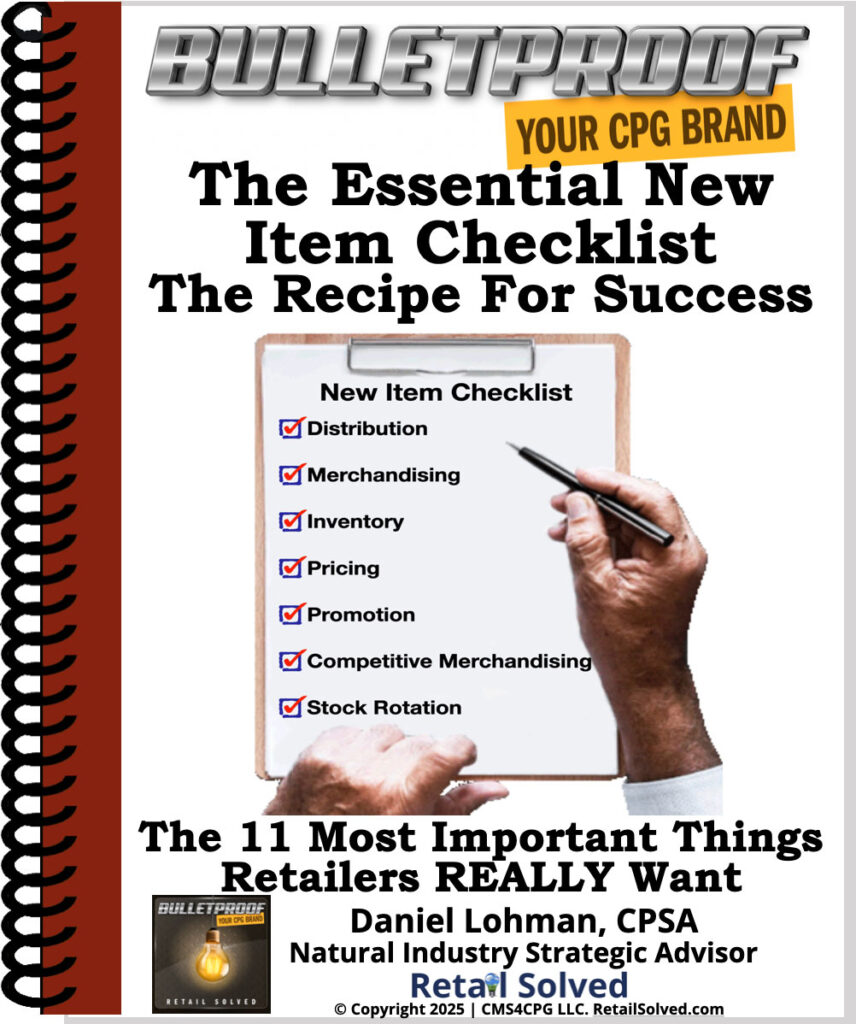
The Essential New Item Checklist – The Recipe For Success
Want A Competitive Edge? The Recipe For Success
New product innovation is the lifeblood of every brand. New products fuel sustainable growth, attract new shoppers and increase brand awareness. Learn the critical steps to get your product on more retailer’s shelves and into the hands of more shoppers. Maximizing your trade marketing can pour rocket fuel on your launch.
Image is the property of CMS4CPG LLC, distribution or reproduction is expressively prohibited.
